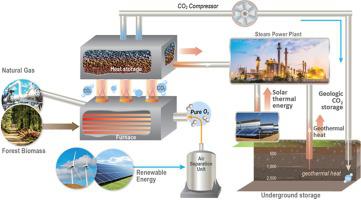Energy Conversion and Management ( IF 9.9 ) Pub Date : 2021-07-16 , DOI: 10.1016/j.enconman.2021.114496 Thomas A. Buscheck 1 , Ravindra S. Upadhye 2

|
We assess a hybrid-energy approach that modifies a steam-turbine power plant to use renewable energy sources (electricity, plus options for geothermal and solar heat), plus fossil fuel (natural gas and coal) and/or waste biomass (e.g., Douglas fir woodchips). Heat storage allows heat to be created during periods of excess energy supply and for that heat to be converted to electricity when demanded. Excess electricity, such as from variable renewable energy (VRE), is used to generate oxygen for oxy-combustion furnaces that create very-hot, high-purity CO2 that heats granular rock beds in insulated vessels. Cool CO2 leaving the beds is dried, sent to compressors powered by excess VRE electricity, before being sent by pipeline to geologic CO2 storage. Very-hot CO2 transfers high-grade heat from storage to the power plant in a closed loop that returns medium-grade heat back to storage, allowing low- and medium-grade renewable-heat sources to be stacked beneath combustion heat, with all heat sources being converted to electricity at the same (high) thermal efficiency. Reliable, on-demand power may be generated with near-zero CO2 emissions with fossil fuel and with negative CO2 emissions with waste biomass. Our analyses show that with fossil fuel, up to 35% of gross power can be derived from renewable sources, while for waste biomass, it can be entirely derived from renewable sources. Because our approach has the potential to ensure that grids have a continuous supply of clean energy and because electricity is only generated once, when demanded, it could serve as an efficient alternative to bulk energy storage.
中文翻译:

通过储热和氧燃烧实现的混合能源方法可产生接近零或负 CO 2排放的电力
我们评估了一种混合能源方法,该方法修改汽轮机发电厂以使用可再生能源(电力,加上地热和太阳能热的选项),加上化石燃料(天然气和煤)和/或废弃生物质(例如道格拉斯冷杉木片)。蓄热允许在能源供应过剩期间产生热量,并在需要时将热量转化为电能。多余的电力,例如来自可变可再生能源 (VRE) 的电力,用于为氧气燃烧炉产生氧气,氧气燃烧炉会产生非常热的高纯度 CO 2来加热绝缘容器中的颗粒岩床。离开床的冷 CO 2被干燥,送到由多余的 VRE 电力驱动的压缩机,然后通过管道送到地质 CO 2贮存。非常热的 CO 2在一个闭环中将高品位热量从储存器传输到发电厂,该回路将中品位热量返回储存器,允许中低品位可再生热源堆积在燃烧热量之下,所有热源以相同(高)的热效率转换为电能。可以在使用化石燃料和负 CO 2 的情况下以接近零的 CO 2排放产生可靠的按需电力废物生物质排放。我们的分析表明,对于化石燃料,高达 35% 的总电力可以来自可再生能源,而对于废弃生物质,它可以完全来自可再生能源。因为我们的方法有可能确保电网持续供应清洁能源,并且因为电力仅在需要时产生一次,所以它可以作为大容量储能的有效替代方案。







































 京公网安备 11010802027423号
京公网安备 11010802027423号